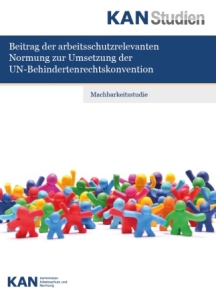KANBrief 2/16

In the field, two extreme positions are encountered on the subject of inclusion. At one extreme, calls are made for products to be usable by anyone, whether disabled or not. At the other extreme, the instructions for use of consumer products permit their use by persons with sensory, physical or cognitive impairments only under supervision, if at all. Is a compromise between these two extremes possible?
In 2011, the German Social Accident Insurance (DGUV) adopted an action plan for implementation of the United Nations Convention on the Rights of Persons with Disabilities (see KANBrief 2/16). For the occupational sphere, the action plan's target is the promotion of a diverse and inclusive world of work and education. To this end, the DGUV "lobbies for safe and healthy working conditions, including for persons with disabilities. [...] In order to attain its targets, the DGUV will review and if necessary revise standards and regulations within its own scope with regard to how they address the specific needs of persons with disabilities; through its presence on state committees, lobby for consideration to be given to the particular needs of persons with disabilities; increasingly integrate the perspectives of persons with disabilities in current and future activities, including those in the area of prevention, and in new research projects."
KAN Study
One of the proposals derived from this aim was addressed to KAN: a feasibility KAN Study (pdf, study conducted by the ASER Institute; in German, summary in English): "The contribution of OSH-related standardization to implementation of the UN Convention on the Rights of Persons with Disabilities – Feasibility study" was to determine the contribution that could be made by OSH-related standardization to implementation of the UN CRPD
The method of the study is based upon consideration for the abilities that a user must possess in order to be able to use a product safely and ergonomically. In this process, it must be considered that standards (and products) are not able to take account of all forms of disability, and that the general conditions at workplaces together with the possible measures must be considered on a highly individual basis for persons with disabilities. Above all, the use of special aids must be possible and permissible.
Within the study, standards governing presses, industrial trucks and convection steamers were analysed by way of example. It was found that hardly any of the documents studied made reference to standards, guides, DIN Technical Reports or DIN Handbooks addressing accessibility or particular groups of persons.
In order to ascertain what abilities are required and at what level for use of a particular product or item of work equipment, a model was developed by which products can be evaluated against a range of human abilities and characteristics: sensory, physical, cognitive, allergies and other. Each of these criteria can be classified on a six-level scale (0 = no requirements; 5 = very high requirements must be met/abilities be possessed).
It was observed that even experts not directly involved in the standardization process are able to apply this model to standards governing protective devices and safety aspects (Type B standards). Much greater difficulty is encountered with product safety standards (Type C standards), which comprehensively address more complex technical products. Detailed knowledge is required in this case; this knowledge must be available in particular on the relevant standards committees and, it goes without saying, among the experts in the relevant manufacturing sector.
List of recommendations for standards committees and manufacturers
The assessment model has been incorporated into a list of recommendations published by KAN (pdf, in german) that is intended to raise awareness on standards committees and among manufacturers for aspects of inclusion. The according of greater consideration to inclusion aspects would enable persons of impaired ability to use products and work equipment in a way that is safe and conducive to good health.
The study proposes that a provision be added to standards requiring manufacturers to include a requirements profile for human characteristics and abilities in the user information for their products. The aim is to make the case for manufacturers to consider inclusion aspects, and consequently to promote greater participation in working life by people with disabilities.
Dr. Beate Schlutter